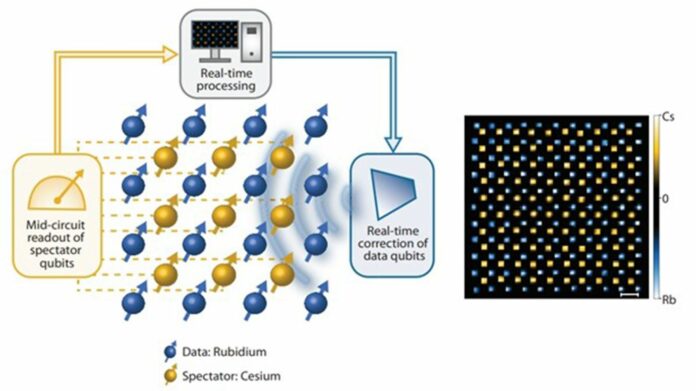Scaling up invariably error-prone quantum processors is a formidable challenge. Although quantum error correction ultimately promises fault-tolerant operation, the required qubit overhead and error thresholds are daunting.
Now, scientists from the Pritzker School of Molecular Engineering at the University of Chicago have created a brand-new technique to continuously monitor the noise surrounding a quantum system and modify the qubits in real-time to reduce inaccuracy.
The method is based on spectator qubits, a group built into the computer that is only used to measure ambient noise rather than store data. The noise in crucial data-processing qubits can be eliminated using the information obtained by such spectator qubits.
According to scientists, this approach can improve the quality of the data qubits. Moreover, it could become essential in the context of quantum computing and quantum simulation.
The team set out to show that their preferred quantum computer—a neutral atom quantum array—could be used to implement this theoretical idea of noise cancellation.
Atoms are held in place in a neutral atom quantum processor using optical tweezers, which Bernien helped create. Each suspended atom in huge arrays functions as a qubit, storing and processing information in its superposition state.
In 2022, Bernien and colleagues first reported the ability to make a hybrid atomic quantum processor containing both rubidium and cesium atoms. They have modified that processor so that the cesium atoms function as spectator qubits and the rubidium atoms serve as data qubits. The researchers created a system that continuously reads data from the rubidium atoms in real time and modifies the cesium atoms using microwave oscillations in response.
Asst. Prof. Hannes Bernien, who led the research, said, “What’s exciting about this is that not only is it minimizing any noise for the data qubits, but it’s an example of actually interacting with a quantum system in real-time.”
Bernien’s team subjected the quantum array to magnetic field noise to evaluate their method for error minimization. They demonstrated that the cesium atoms accurately detected this noise and that their system immediately wiped it out in the rubidium atoms.
Scientists noted, “The initial prototype is just a starting place. They’d like to try increasing the amount of noise and varying the types of perturbations and testing whether the approach holds up.”
“We have exciting ideas on how to improve the sensitivity of this system by a large factor, but it’s going to take more work to implement it. This was a great starting place.”
Journal Reference:
- Singh et al. Mid-circuit correction of correlated phase errors using an array of spectator qubits. Science. DOI: 10.1126/science.ade5337
